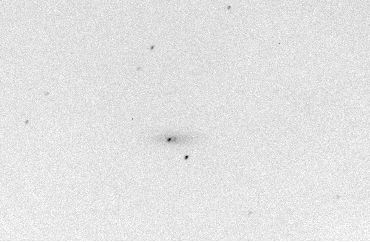
In February of 1995, a supernova in the galaxy NGC 2726 (in Ursa Major) was discovered by the RASC Halifax Centre and Saint Mary's Astronomy and Physics at the Burke-Gaffney Observatory! This was the first discovery of a supernova from within Canada.
The discovery image of SN 1995F
At right is the discovery CCD image (negative) of SN1995F in NGC 2726, taken by David Lane, Paul Gray, and Beverly Miskolczi of Saint Mary's University and the Halifax Centre, Royal Astronomical Society of Canada on the evening of February 10, 1995. The supernova is the dark spot near the centre of the galaxy. It's discovery magnitude was about 15 and was too faint to observe visually through all but the most gigantic amateur telescopes.
IAU Circular on Supernova 1995F in NGC 2726
D. J. Lane and P. Gray, Burke-Gaffney Observatory, Saint Mary's University, report their discovery via CCD on Feb. 10-11 of a supernova located about 2" east and 1" south of the center of NGC 2726 (R.A. = 9h04m.9, Decl. = +59o56', equinox 2000.0). An unfiltered frame on Feb. 14.042 UT showed the object at mag 14.7. A foreground star of mag 14.9 is located 19".6 west and 14".9 south of SN 1995F. A. V. Filippenko and A. J. Barth, University of California at Berkeley, report that preliminary inspection of uncalibrated CCD spectra (range 310-1050 nm, resolution 0.7-1.5 nm) obtained on Feb. 24 with the 3-m Shane reflector at Lick Observatory confirms that this object is a supernova, most likely of type Ic (but possibly Ib), roughly 2-3 weeks past maximum brightness.
Press Release
The Burke-Gaffney Observatory has joined a select worldwide group of astronomical observatories by discovering an exploding star in a galaxy known as NGC 2726. The discovery was made on the evening of February 10 by amateur astronomers Paul Gray, David Lane and M.Sc. student Beverly Werstiuk using an electronic CCD camera on the Observatory's 40-cm reflector, and confirmed on February 24th by observations taken at Lick Observatory in California. Both Paul and David are active members of the Halifax Centre of the Royal Astronomical Society of Canada, and Dave is also employed by Saint Mary's as Observatory Technician. The supernova is officially designated 1995F, since it is the 6th one discovered so far this year.
Known as supernovas, these stellar explosions signal the violent deaths of stars several times more massive than our sun. Supernovas are interesting to astronomers because they manufacture most of the chemical elements that went into making the earth and other planets, and also because distant supernovas can be used to estimate the size and age of our universe.
Supernovas are rare events; the last one in our galaxy occurred several hundred years ago, before the invention of the telescope. The odds of discovery can be increased by repeatedly checking many other galaxies. A new supernova reveals itself as a bright point of light that wasn't there the last time the galaxy was checked. Since a supernova can outshine millions of ordinary stars it is easy to spot with a modest telescope, even in a galaxy like NGC 2726 which is about 70 million light-years away. Despite the importance of supernova studies, only a few observatories around the world spend time searching for supernovas. The reason: examining hundreds of galaxies takes lots of time from other observing projects, and the chance of making a discovery is still small. An intense but friendly competition has developed among these few observatories to be first to discover a new supernova. The present discovery is remarkable because the Burke-Gaffney program is only a five months old. It comes just a few days before narrowly missing the discovery of another supernova in the galaxy NGC 2441 (1995E).
